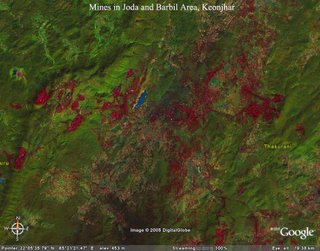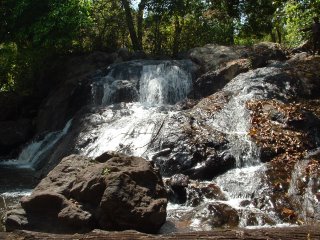Missed blogging for last few days because of committments. I was shocked to know that 20 tribals and dalits of Kashipur movement have been behind bars because of false cases for the last six months. Incredible that policemen who shot dead three adivasis in cold blood in December 2006 are roaming around free whereas people fighting for basic democratic and human rights are being put behind bars. Bravo, Navin. Meanwhile, our friend Prafulla Das has a good article on mining (Privatisation of Orissa's minerals) in current issue of frontline.
Another interesting link is of a petition by Sankarshan Acharya which requests the Supreme Court to intervene in the destructive mining policy of the GOI and GOO. The detailed petition in pdf format is at this address.
Following the protests against the mining of Malangtoli by Orissa Sponge Iron Ltd., the local mining mafia has swung into action, and in an article in Sambad ( an Oriya newspaper) have issued veiled threats against the activists fighting against the mining. The article itself is highly biased and reflects the situation in Orissa journalism.The english translation is as below:
"Action will be taken against so called environmentalists protesting mining operations in Malangtuli
Sambad
15 November, 2005
Some people are protesting the Malangtuli mining operation for their selfish interests. These people are even creating obstruction in the path of employment of hundreds of unemployed youth. Ex-MLA Khethamohan Nayak has said that such type of protests will not be tolerated and necessary actions will be taken against the so-called environmentalists.
It's worth noting that Orissa Sponge Iron Ltd had taken lease of 459ha land in Luhakhola-Kadakola area for mining purposes. The company had asked permission from the Pollution Control Board (OPCB) for this. The PCB had asked the local people for their opinion. A public hearing was organized in Kadakaola where the chairman of PCB was present. He heard the complaints from the people. Nearly all categories of people present gave consent for the mining prospect. The Joda Environment Protection Committee gave some constructive suggestion in regard to the mining operation. But it was seen on Doordarshan Oriya News that on 8th of Nov. some people raised their voices against the project and said that if the mining operation is carried out here, then the Khandadhara waterfall will be affected.
Ex MLA Khetramohan Nayak.said that the fact is that Khandadhara Waterfall is situated 12 to 13 K.M from the mining site. Besides that, there are mountains around the mining area so the waterfall could not be affected. This is written in the demand note give to the District collector. He also mentioned that that some people for their self interest are protesting against the industrialization in Keonjhar District and are making a conspiracy.
Kadakala Sarapanch Narayan Dehuri, BJP Leader Chandrasekhar Pradhan, Joda Environmental Protection Committee's President Kalakara Nayak and Secretary Udaya Sankar Acharya, Karunakar Patra, Bhubaneswar Das etc. warned the protesters against trying to stop mining."
This is interesting - and a part of the larger mining game i.e. purchase the local goons and petty politicians, create "environmental protection committees" and get them to support mining and threaten anyone who comes in the way of the "loot".
"Public Hearing" for Vedanta's Aluminium Smelter near Jharsuguda schdeuled for 9th december, 2005.
Inspite of the Vedanta's problems in Lanjigarh, it is going ahead with the public hearing for environmental clearance for its aluminium smelter near Jharsuguda on 9th December, 2005. This is a huge plant with a capacity of 4,50,000 tonnes per annum. This was scheduled to be held in last month but was postponed. The original EIA for the smelter mentions that the alumina will be sourced from Lanjigarh Alumina refinery, but that one is sub-judice at present with the Supreme Court.
The area where the smelter is being set up is next to a series of plants and factories being set up along the Sambalpur-Jharsuguda highway. The site offers great advantages to the Vedanta, nearby source of water from Hirakud reservoir, ample coal from IB valley for running captive power plant, and direct railway line from Lanjigarh. Of course, the water from Hirakud currently used for irrigation will be diverted for the smelter, and one can imagine the amount of pollution caused by the smelter as well as the power plant being set up.
Also, as the Google satellite picture below shows - the area where the plant is coming up is smack in gap between two major forest patches in Orissa - the one comprising Badarama-Ushakothi sanctuary and the forest areas to the north west of Hirakud reservoir. Local people say that the area is being used as an elephant corridor. Most of the route is already blocked by the present upcoming industries and the IB valley coal field, and rest will be blocked by the Vedanta smelter.







